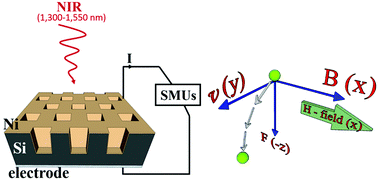Magnetic fields affect hot electrons in silicon-based photodetectors at telecommunication wavelengths†
Abstract
The core assumption of Fowler theory is that excited hot electrons are distributed isotropically in momentum space inside a metal, and only a small fraction of the hot electrons within the emission cone perpendicular to the Schottky junction can possibly be injected into the semiconductor contact. A clearer understanding of the direction and momentum space of hot electrons should aid the development of various hot electron-based devices. In this study, in contrast to the assumption of Fowler theory, we first proved experimentally that the direction of hot electrons is highly related to the polarization state of the incident light. Furthermore, the anisotropic movement of hot electrons can be exploited, through the application of a magnetic field, to modulate the optoelectronic response to silicon (Si)-based photodetectors that operate at optical telecommunication wavelengths. Instead of using a noble metal, we applied nickel (Ni), a ferromagnetic material, to construct a hot electron-based photodetector for the detection of infrared (IR) radiation with photon energy well below the band edge of Si. We designed a series of experiments to verify the directionality and transport of hot electrons within the Ni–Si Schottky diode. When a magnetic field was applied to the device, the effects of Lorentz force and anisotropic magnetoresistance (AMR) greatly affected the transport of hot electrons. Furthermore, taking advantage of the anisotropic movement of hot electrons and magnetic effects, we could selectively enhance or weaken the IR radiation-induced signals. In addition, our device could be switched from polarization-insensitive to polarization-sensitive by applying a magnetic field. To the best of our knowledge, this study, combining the electrical, magnetic, and optical effects of hot electrons and Si-based devices, is the first to modulate the efficiency of Si-based photodetectors working at optical telecommunication wavelengths. This strategy would, presumably, also be potentially very useful when applied to other hot electron-based systems and devices.



 Please wait while we load your content...
Please wait while we load your content...